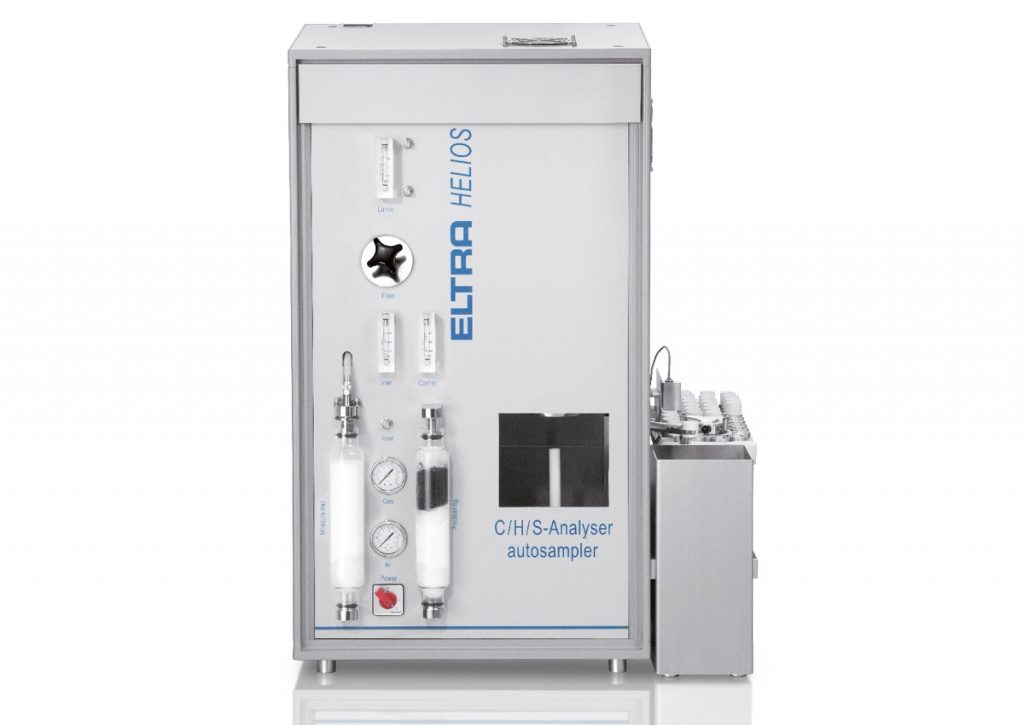ELTRA‘s CHS-580A is the ideal analyzer for the simultaneous determination of carbon, hydogen and sulfur in organic samples.
ELTRA’s 580A analyzers (A = Autoloader) are equipped with an automatic sample loader, allowing for analysis of large numbers of samples without operator intervention. The sample loader is available in two versions to accommodate 36 or 130 crucibles. The CHS-580A is based on the technology of the CHS-580 analyzer and features a vertical resistance furnace with ceramic tube.
The temperature can be set in steps of 1 °C to a maximum of 1,550 °C. Thanks to sample weights of up to 500 mg and more even inhomogeneous materials can be reliably analyzed. The analyzer can be equipped with up to three independent infrared cells according to the user’s requirements, allowing for a great variety of applications.

coal, coke, oil, plant materials, rubber, soot, tobacco, waste, …
| Measured elements | carbon, hydrogen, sulfur |
| Samples | organic |
| Furnace alignment | vertical |
| Sample carrier | ceramic crucibles |
| Field of application | agriculture, biology, chemistry / plastics, coal / power plant, construction materials, environment / recycling, medicine / pharmaceuticals |
| Furnace | resistance furnace (ceramic tube), adjustable up to 1550 °C (steps of 1 °C) |
| Detection method | solid state infrared absorption |
| Number of IR cells | 1 – 3 |
| Material of IR path | gold |
| Typical analysis time | 60 – 180 s |
| Chemicals required | magnesium perchlorate, sodium hydroxide |
| Gas required | oxygen 99.5 % pure (2 – 4 bar / 30 – 60 psi) compressed air (4 – 6 bar / 60 – 90 psi) |
| Power requirements | 230 V, 50/60 Hz max. heat up current 2000 W |
| Dimensions (W x H x D) | 55 x 100 x 60 cm 85 x 35 x 45 cm (Autoloader for 130 crucibles) |
| Weight | ~ 90 kg (analyzer) ~ 15 kg (Autoloader for 130 crucibles) |
| Required equipment | PC, balance (resolution 0.0001g), monitor |
| Required accessories | Autoloader (for 36 or 130 crucibles) |
| Optional accessories | TIC module, voltage stabilizer 5 KVA |
Operation CHS-580A
In the CHS-580A the samples are weighed into crucibles. Then a gripper places the samples from the Autoloader on the pedestal. The samples are loaded consecutively into the furnace for combustion. The average analysis time is 60 to 180 seconds. Detector signals and instrument parameters are displayed during analysis. Evaluation of the signals and display of the results are done automatically; the data can be transferred to a laboratory information management system (LIMS). The analyzers require minimum maintenance. The particle filters and chemicals which need to be maintained are easily accessible.
Measuring Principle CHS-580A
In the CHS-580A analyzer the sample is burnt in an oxygen atmosphere at temperatures of up to 1,550 °C. The furnace temperature can be freely selected in steps of 1 °C. The combustion gasses (CO2, H2O, SO2) coming from the furnace first pass through a dust filter and then into the heated H2O infrared cell. After the water vapor is chemically absorbed, the dried CO2 and SO2 gas is detected in the additional infrared cells. Depending on the configuration, it is possible to combine up to four infrared cells with different sensitivities.
Content may be subject to modifications or corrections
Romquest Technologies is the exclusive Canadian distributor for reputable manufacturers of high quality analyzers and consumables from Europe and USA. Our product lines include: Eltra Elemental Analyzers, Eurovector CHNS/O and N-Protein Analyzers, Belec Optical Emission Spectrometers, Rigaku Handheld LIBS Analyzers, Radwag Balances & Scales and Alpha Resources consumables, supplies and certified standards for elemental analyzers/ICP/AA/MS.